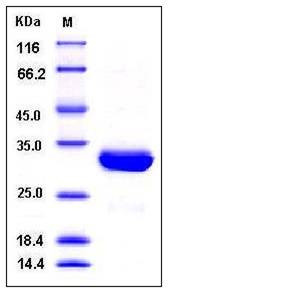Human SCGN / Secretagogin Protein (His Tag)
CALBL,DJ501N12.8,SECRET,SEGN,setagin
- 100ug (NPP4246) Please inquiry
| Catalog Number | P12411-H07E |
|---|---|
| Organism Species | Human |
| Host | E. coli |
| Synonyms | CALBL,DJ501N12.8,SECRET,SEGN,setagin |
| Molecular Weight | The recombinant human SCGN consisting of 286 amino acids and has a calculated molecular mass of 33.4 kDa. It migrates as an approximately 32 kDa band in SDS-PAGE under reducing conditions. |
| predicted N | Met |
| SDS-PAGE |  |
| Purity | > 97 % as determined by SDS-PAGE |
| Protein Construction | A DNA sequence encoding the human SCGN (NP_008929.2) (Asp 2-Pro 276) was expressed, with a polyhistide tag at the N-terminus. |
| Bio-activity | |
| Research Area | Neuroscience |Neurology process |Neuroregeneration |
| Formulation | Lyophilized from sterile PBS, pH 7.4 1. Normally 5 % - 8 % trehalose and mannitol are added as protectants before lyophilization. Specific concentrations are included in the hardcopy of COA. |
| Background | Secretagogin, also known as SCGN, is a secreted protein which is detectable in human serum after ischemic neuronal damage. It is a recently described calcium-binding protein. Secretagogin / SCGN is expressed at high levels in the pancreatic islets of Langerhans and to a much lesser extent in the gastrointestinal tract (stomach, small intestine and colon), the adrenal medulla and cortex and the thyroid C-cells. In the brain, the expression of Secretagogin / SCGN is restricted to distinct subtypes of neurons with highest expression in the molecular layer of the cerebellum (stellate and basket cells), in the anterior part of the pituitary gland, in the thalamus, in the hypothalamus and in a subgroup of neocortical neurons. Secretagogin / SCGN is widely expressed in prostatic adenocarcinoma as opposed to adenocarcinomas in other organs. The function of Secretagogin / SCGN is unknown, but it has been suggested in beta-cells to influence calcium-influx and has been observed downregulated in diabetes-prone BB rat islets exposed to cytokines. Secretagogin / SCGN is involved in the calcium metabolism of tumour cells and endothelial cells in a subset of neoplasms of the brain and its coverings. Secretagogin / SCGN is also a novel marker for neuroendocrine differentiation. |
| Reference |
